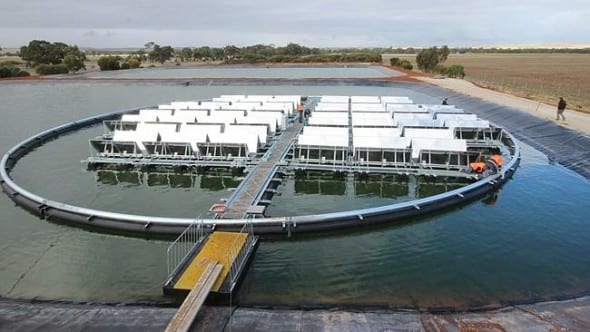The city of Lismore in the north of New South Wales has called for tenders for a “floating solar plant” that will be community funded, and located on top of one of the settling ponds in its sewage treatment plant.
The tender for the 99.9kW project went out on Wednesday. The plant will not be the first floating solar plant in Australia – that honour is held by a project in Jamestown, but it could be the biggest, and certainly the first community funded solar plant.

The Jamestown project (pictured above), while touted as a 4MW project, has only been built out to 30kW in its first stage, so if the Lismore project gets to 99kW before the Jamestown project is expanded, then it will be the biggest, at least for a while.
The Lismore project is part of a unique partnership between the council and the community, where two 100kW projects are funded by the community, with the money lent to the council to build the project, and then repaid with interest at a commercial return to the investors.
Lismore is also pursuing a 100 per cent renewable energy target by 2023, and has launched a range of initiatives, including ownership of electric vehicles.
The tender for the floating solar project was launched at the same time as tenders for a 99.9kW solar project on the
Goonellabah Sports & Aquatic Centre, and a total of 70kW of rooftop solar on the Lismore community Centre, the Lismore library, the Oakes Oval pavilion, and a council depot.
The highlight though is the call for “an innovative floating concept on the settling ponds at the East Lismore Sewage Treatment Plant.”
Lismore Council’s environmental strategies officer Sharyn Hunnisett said the idea for a floating system in Lismore was born of necessity.
“It basically came about because of spatial concerns – we simply didn’t have enough roof or land space at the East Lismore Sewage Treatment Plant. Then it hit us – we have this huge body of water, why not use that?”
The settling ponds at the East Lismore Sewage Treatment Plant provide a large body of water with low velocity, perfect for a floating solar farm. “This concept resolves the major site constraint of land/roof space and results in further benefits including optimal operation and longevity of the panels due to lower temperatures, minimising evaporation, and algal growth on the pond,” Hunnisett said.
Floating solar has become popular in many countries. The world’s biggest floating solar array was recently installed in London, on a reservoir. Floating solar arrays are also being used on dams in China and India, in bays in Japan, and in Korea, the US, and Brazil.
Infratech, which built the Jamestown plant, has also sold its technology to US customers, and is building a 1MW floating solar project in the city of Holtville in California, also on a waste water treatment plant.
Another Australian start-up Sunengy recently completed a pilot plant on a hydro dam in India in partnership with local industrial giant Tata.
Inspectors talked to the staff at the sewage treatment plant and tried to determine the best location for the solar farm. The investigation team looked at existing rooftops and other structures as possible sites where the solar arrays could be installed.
The system that will be installed at the site will be at the 99 kilowatt range and will have 300 solar modules. A full feasibility study for the project which will determine the most appropriate system size for the plant given its energy use has yet to be conducted.










